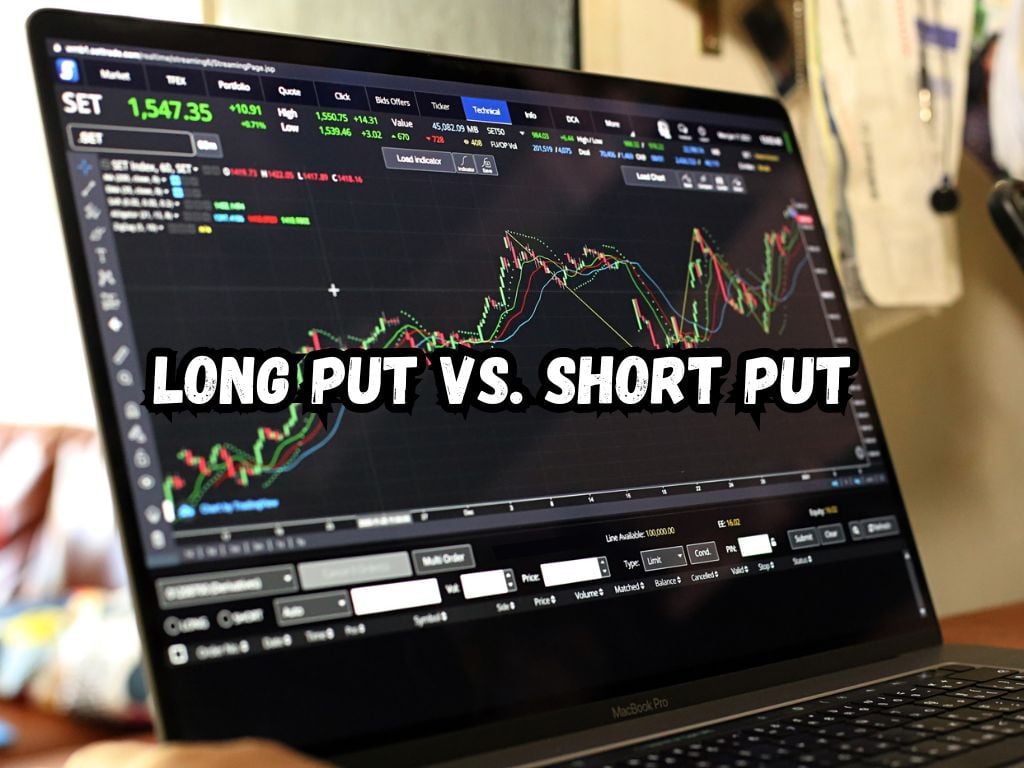Options trading offers investors a diverse set of tools for speculation and risk management, with put options playing a central role.
Two opposing strategies using put options are the ‘long put’ and ‘short put’, each catering to different market outlooks and risk appetites.
Understanding the nuances between long put vs short put is crucial for anyone looking to navigate the options market effectively.
Understanding Options: The Basics
Options are financial derivatives that give buyers the right, but not the obligation, to buy or sell an underlying asset at a predetermined price within a specific period.
The key components of an option are the strike price, the expiration date, and the premium (the price paid for the option).
Long Put
Definition and How It Works
A long put strategy involves buying a put option. This position gives the option holder the right to sell the underlying security at a predetermined price before the option expires.
Investors adopt this strategy primarily when they anticipate that the market price of the underlying asset will decline significantly before the option expires.

Why Investors Choose Long Put
The long put is favored for speculating on asset price declines without risking more than the option’s premium. It’s also a way to hedge against potential downturns in portfolios, especially if the assets are at risk of losing value.
Potential Profits and Risks
The main advantage of a long put is that the profit potential can be substantial if the underlying asset’s price falls below the strike price by more than the premium paid.
However, if the stock price remains above the strike price, the loss is limited exclusively to the premium.
Example of Long Put
Consider an investor who buys a put option with a strike price of $50 for a premium of $5. If the stock falls to $30, the investor can exercise the option, effectively selling the stock for $50. After accounting for the $5 premium, the net profit is $15 per share.
Short Put
Definition and How It Works
Conversely, a short put involves selling a put option, which obligates the seller to buy the underlying asset at the strike price if the buyer exercises the option.
This strategy is suitable when the seller believes that the asset’s price will rise or stay above the strike price until expiration.
Why Investors Choose Short Put
Selling a put option can generate income through the premiums received. It’s an attractive strategy during stable or rising market conditions.
Potential Profits and Risks
The maximum profit of a short put is restricted to the premium received. However, the risk can be considerable if the asset’s price falls far below the strike price, as the seller must purchase it at the strike price, potentially incurring large losses.
Example of Short Put
If an investor sells a put option on a stock with a strike price of $50 and collects a $5 premium, the maximum profit is the premium.
However, if the stock price drops to $30, the investor must buy it at $50, incurring a substantial loss after the premium is considered.
Long Put vs Short Put: Key Differences
The primary difference lies in the market outlook and risk exposure. Long puts are used when expecting a stock price decline; they offer substantial profits but with limited risk (the premium paid).
In contrast, short puts are used when anticipating stable or increasing prices; they offer immediate income through premiums but risk significant losses if predictions fail.

Strategies and Considerations
Choosing between a long and a short put largely depends on market conditions and personal risk tolerance.
Long puts are preferable in volatile or declining markets, while short puts are better in stable or rising markets. It’s essential to understand not only the market trend but also the specific assets involved.
Pro Tips for Trading Put Options
Effective management of time decay is crucial; options lose value as expiration approaches. Monitoring volatility is also important because it can greatly affect premiums and thus both the strategies’ risks and rewards.
Choosing optimal strike prices and managing potential losses proactively can define successful trading outcomes.
Frequently Asked Questions
What determines the price of a put option?
The price, or premium, of a put option is influenced by factors including the intrinsic value of the option, its time value (related to the expiration date), and the volatility of the underlying asset. Broader market conditions and the underlying asset’s price movement also play significant roles.
Can you lose more money than you invest in put options?
In a long put strategy, the investor cannot lose more than the premium paid for the option. However, in a short put, potential losses can exceed the premium received if the underlying asset’s price falls substantially.
How do expiration dates affect put options?
Options are time-sensitive. As the expiration date approaches without the option moving in-the-money, its value decreases—a phenomenon known as time decay. This particularly affects short put sellers, who benefit from time decay, and long put buyers, who suffer from it.
What is the impact of volatility on put options?
Higher volatility increases the premiums of put options, because the likelihood of the stock price moving significantly before the option expires is greater. This can affect both long and short put strategies by either increasing potential profits or risks.
In trading, the direct approach often yields the best results. By understanding the straightforward tactics and risks involved in long and short put options, investors can confidently navigate this segment of the financial markets.
Conclusion
Both long and short puts have their place in investment strategies. By understanding and applying these strategies judiciously, traders can enhance their portfolios’ potential in various market conditions.
Solid knowledge and tactical application of long and short puts can lead to profitable and protected participation in the options market.


 Tags:
Tags:










